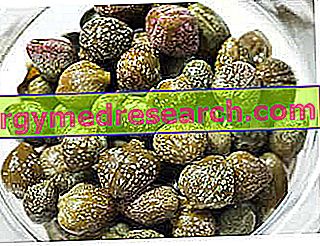What are Capers
Capers, intended as a widely consumed food, are the buds of Capparis spinosa, a small woody shrub typical of the Mediterranean basin.
The caper plant, native to Asia Minor and Greece, is fond of calcareous, steep and dry soils.

To be precise, the caper is not a tree, but a shrub. Its aerial fraction (consisting of falling or creeping branches) often makes it hardly visible, as it does not reach significant heights. It is not uncommon for the caper plant to grow between the cracks in the walls, between the cracks of the rock or between the piles of stones.
As we have said, capers are NOT fruits, but flowers (or rather buds, therefore flowers still open). This means that, from the moment the plant appears to be well "flowered", most of the edible portion is no longer available.
The caper (bud) is small (varying between 0.5-1.5cm in length), a green color often variegated with reddish and a slightly pointed spherical shape in the vertex opposite to the petiole.
CAUTION. It is necessary to distinguish the caper properly called (bud) from the edible fruit ( cucuncio ). This, of ellipsoidal section, therefore of elongated shape, is (roughly) of the same color but of superior dimensions (≥2.0cm).
Nutritional Features
Capers have a very low energy value, supplied mainly by complex carbohydrates. Lipids are almost absent (but mainly unsaturated) and proteins (with a low biological value) are not significant.
A considerable fiber content is evident, while cholesterol is absent.
| Composition for 100g of packaged capers | |||||||||||||||||||||||||||||||||||||||||||||||||||||||||||||||||||||||||||||||||||||||||||||||||||||||||||||||||||||||||||||||||||||||||||||||||
 | |||||||||||||||||||||||||||||||||||||||||||||||||||||||||||||||||||||||||||||||||||||||||||||||||||||||||||||||||||||||||||||||||||||||||||||||||
Nutritional values (per 100 g of edible portion)
| |||||||||||||||||||||||||||||||||||||||||||||||||||||||||||||||||||||||||||||||||||||||||||||||||||||||||||||||||||||||||||||||||||||||||||||||||
With regard to vitamins, we can distinguish retinol equivalent concentrations (vit. A), alpha-tocopherol (vit. E), ascorbic acid (vitamin C) and folate (not visible in the table), but none of these in quantity very high.
From the saline point of view, the predominant element of capers preserved in salt is sodium, the excess of which is harmful to the health of the hypertension; just think that in 20 grams of salted capers there is the same amount of sodium contained in 150 liters of mineral water.
There is no lack of good doses of manganese, iron, magnesium and copper (some not visible in the table).
Herbal Properties
In the herbalist field, orally, the caper is used above all the rind; it contains capparirutin (a bitter glucoside ) with diuretic and anti-arthritic properties.
The bark and root of the plant (but also the leaves, although less used) are very rich in quercetin, a flavonoid with a strong antioxidant function and protector of blood vessels; the most common application is for topical use.
Gastronomic Applications
The capers have a strong and penetrating taste; they are picked and preserved in oil, in vinegar or in salt. In the kitchen, they are used to flavor other foods such as first courses, main courses, sauces and condiments.
The best capers are those preserved under coarse sea salt; this preservation method guarantees the maintenance of the organoleptic characteristics without resorting to additives instead added to the pickled products.
The capers are also marketed in different sizes; the smaller ones are considered more valuable and can be consumed whole. The larger capers are more tender and can be used chopped to embellish sauces and fillings.
By virtue of the considerable diffusion and assiduous use in Sicilian gastronomy, capers have been included among the Traditional Italian Agro-food Plates (PAT) of the Sicily region.
Extremely delicious and known throughout the world are the Pantelleria capers (produced on the island of the same name) which, in 1996, obtained the Protected Geographical Indication (IGP) certification. The typical geographical location, the humidity and the volcanic soil give the Pantelleria capers a characteristic aroma that distinguishes them from other products in the rest of the world.
The fruits of the caper are used in a similar way to the buds or, for the lovers, deprived of the stem and as a side dish. For those approaching consumption of the cucunci for the first time, I suggest carrying out an additional processing, that is to say, to engrave them longitudinally and empty them of the seeds; these, particularly numerous, can sometimes be unpleasant during chewing.
The commercially available capers can be salted, in oil or in vinegar. Qualitatively speaking, the best are the salted ones even if, due to the excess of sodium, at the time of purchase they are often discarded for the benefit of others. What many people are unaware of is that it is still possible to remedy the excessive salt content by thoroughly rinsing the capers and placing them in a cold water bath for about ten minutes; it is also a good rule not to add salt to the dishes when they are enriched with capers.
Video recipes with capers
Cultivation notes
The caper is a plant quite simple to maintain; it can be grown by sowing (not very productive) or by grounding cuttings (at least 2-3 years of age). Obviously, it is not possible to leave aside a "Mediterranean" climate and flowering seems satisfactory with scarce or medium-sized irrigation. The harvest of these small buds of intense green color takes place between the end of May and the beginning of September (according to the areas), just before their flowering.



